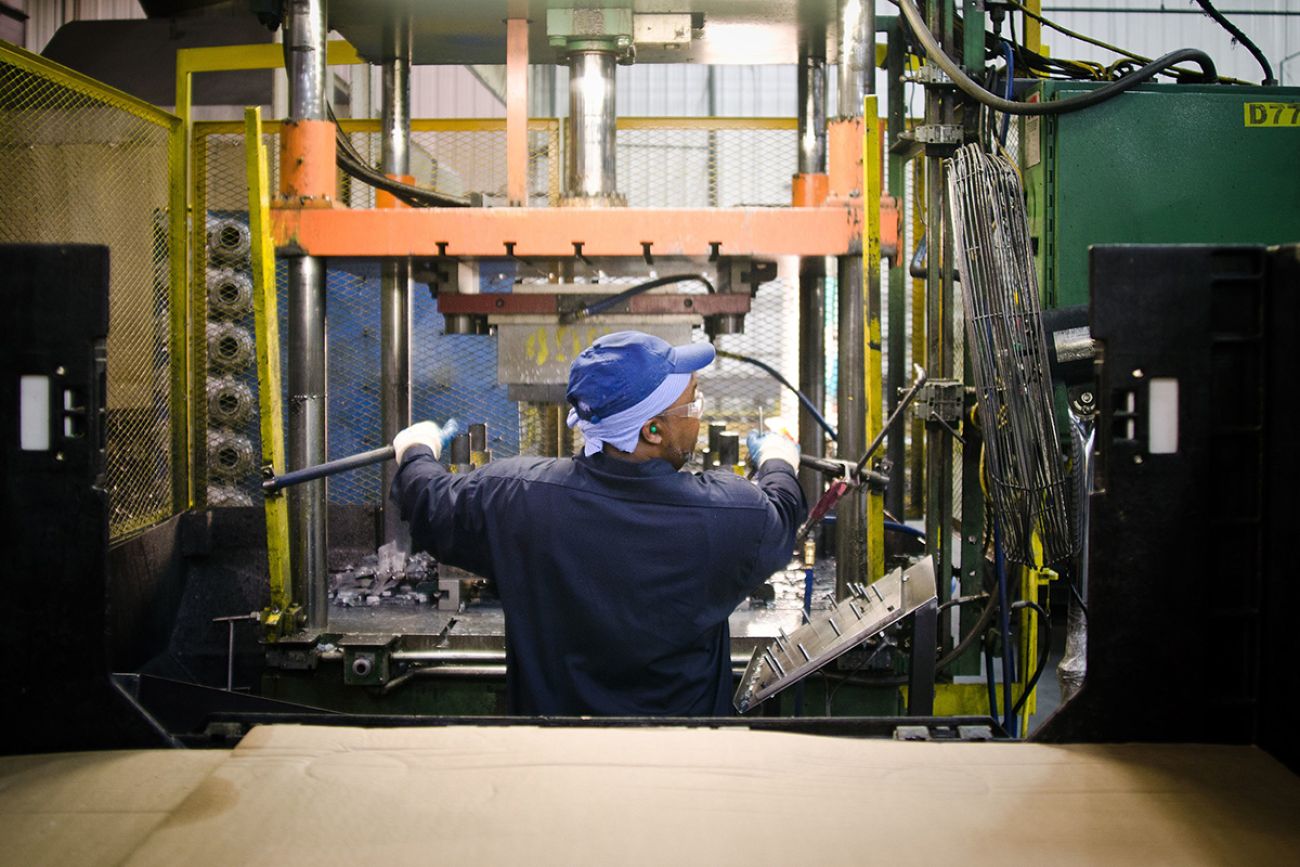In Michigan, 60% of jobs don’t pay middle-class wages. Can state stop slide?

A trim operator works in a die-castings factory in Muskegon. For decades, Michigan’s economy was dependent on manufacturing. Pay has fallen in recent years and the state now ranks 39th in per-capita income. (Photo courtesy of Wikimedia Commons, Lance Cheung and the U.S. Department of Agriculture)
by Paula Gardner (Bridge Michigan)
Debate about the effectiveness of corporate subsidies in Michigan is increasing, as experts and business leaders worry the state and its workers are rapidly losing ground.
Michigan wages have fallen dramatically compared to other states since 2000, and the state has lost on some high-profile investments, prompting Gov. Gretchen Whitmer to bet big on business incentives in 2022 with a $2 billion fund to compete for big job-creating projects.
But a Bridge Michigan investigation found the median pay for jobs created with the help of $335 million in subsidies last year is about $24 per hour. That’s well under the $64,130 to about $70,000 per year generally considered middle income.
Half of the 11,408 promised jobs from the subsidies will pay even less than $50,000.
Today, many groups are sounding alarms about both Michigan’s moribund population and potential slide toward becoming one of the least-prosperous states in the nation.
At the same time, Michigan’s Legislature is weighing job-creation strategies that include incentives that require companies to pay more if they receive public money.
Here is what to know about Michigan and efforts to increase prosperity:
Multiple experts are lining up behind the issue
Business Leaders for Michigan has had a long goal of making Michigan a “Top 10 state” for jobs, education and personal income. But in 2023, the coalition of CEOs of the state’s largest and most influential businesses concluded: “We’re a below average state,” ranking Michigan 31st in the nation.
The group is urging greater emphasis on programs that promote education, vibrant communities and entrepreneurs. It supports new incentives, including a payroll tax credit for expanding the number of higher-paying jobs and a research and development tax credit.
Whitmer has said she supports both, and the Legislature is considering proposals.

The average annual salary for Michigan science and technology employees is over $91,000, twice the state median.
The Growing Michigan Together Council, formed in 2023 by Whitmer to offer recommendations to jump-start the state’s population, is also working to stem Michigan’s prosperity losses.
Its recommendations include boosting educational attainment and increasing funding, measures that it says will help retain young, educated residents.
Home to 10 million residents, Michigan ranks 49th in the nation for population growth since 1990, behind only West Virginia.
Still behind
Ann Arbor-based think tank Michigan Future Inc. has warned for 20 years that the middle class is at risk of slipping away in Michigan, as well-paid manufacturing jobs decline and those that require college degrees increase.
Now, 6 in 10 Michigan jobs pay less than what is required for a family of three to be considered middle class, according to the group.
Like the business group, Michigan Future connects prosperity to education. Its research also shows that prosperous states invest in vibrant urban centers that appeal to younger and educated workers and high-paying employers.
Michigan’s per-capita income was above average for most of the 20th century, said Lou Glazer, president of Michigan Future Inc.
As of 2022, the rate was $57,038, 13% below the national average of $65,470, according to census data. That’s 39th in the nation, the lowest in the Midwest.
In 1999, Michigan ranked 16th in the nation.
Actual wages are even lower
The median pay for full-time workers in the state ages 16 and older was $55,432 in 2022, the most recent data available. This figure includes bonuses and overtime.
Actual pay may even be lower for many workers. Median pay does not factor in wages for part-time and seasonal workers.
Add those two categories back in, and the median earned wage plummets to $40,610 per year.
Looking ahead: falling further?
If each state's personal income per capita were to grow over the next 23 years at the same rate as between 1999 and 2022, Michigan would end up in 48th place by 2045, just above Alabama and Mississippi, according to the report from Michigan Future Inc.
Further, if all states saw income per capita grow at the same rate as it did from 2012 to 2022, Michigan would rank 34th.
Where is Michigan losing ground?
In addition to wages, Income per capita includes transfer payments (like government assistance and Social Security) and capital income, such as from investments.
Weak growth in wages in Michigan accounts for most of the growing gap between the state and the U.S. in personal income per capita, according to Michigan Future Inc.
One notable aspect of that softness comes from auto manufacturing employment falling in Michigan since 2000, but that’s only the second-largest decline that is fueling the gap.
To be sure, auto wages fell from 15.5% of all earnings in Michigan in 1999 to 7.9% in 2022. The difference accounts for 23% of the gap between Michigan and U.S. incomes.
But Michigan is not keeping pace with the nation in attracting higher-wage jobs requiring higher education, and that caused a 29% gap between Michigan and national income averages.
What types of jobs does Michigan need?
Experts say the solution to raising prosperity is attracting more higher-wage jobs, or so-called “knowledge economy jobs” that typically require a four-year college degree.
Michigan trails the U.S. in those knowledge economy jobs, according to Business Leaders for Michigan data, with the gap growing. By 2022, Michigan’s gain of those jobs was flat compared to 2000, while nationally they grew by 35%.
Last year, 88% of incentives went to manufacturing or advanced manufacturing firms, which included producing auto parts, airplane components, food flavors and hockey tape.
In contrast, 9% of the state’s incentives went to technology-based jobs. The companies receiving those subsidies plan jobs that will pay an average of $104,045 per year.
— Mike Wilkinson contributed










You must be logged in to post a comment Login